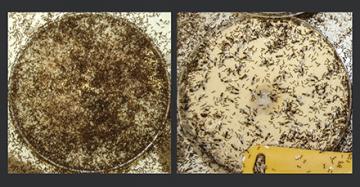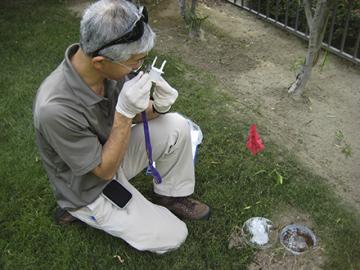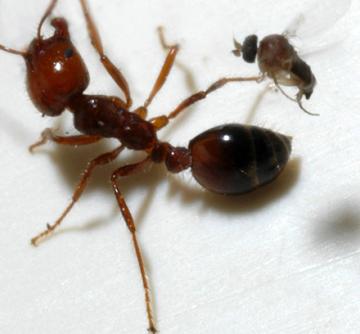Natural Enemies Close In on Fire Ants
Hunting for natural enemies of the red imported fire ant is paying off for Agricultural Research Service (ARS) scientists. Their latest discovery—a new virus found in fire ants from Argentina—has the potential of becoming a biological control agent against the red imported fire ants infesting the United States.
When the red imported fire ant, Solenopsis invicta, invaded the United States in the 1930s, it left most of its natural enemies behind in South America. The pest quickly spread throughout the southeastern United States, reaching populations up to 10 times those found in its native country, Argentina. Today, these ants are a serious threat to human and animal health; the damage that they cause and efforts to control them cost over $6 billion annually.
“In Argentina, the fire ant is not really a problem because it has many natural enemies there,” says entomologist Steven Valles, with ARS Center for Medical, Agricultural, and Veterinary Entomology (CMAVE) in Gainesville, Florida. “But in the United States, this ant is a serious problem because populations are growing unchecked. There’s nothing to constrain them.”
At CMAVE’s Imported Fire Ant and Household Insects Research Unit, work involves identifying natural enemies—pathogens and parasites—that can be released safely into the United States and used as a natural control that’s sustainable. The biocontrol agents that have been released into the United States were first demonstrated to be specific to fire ants and harmless to other organisms. These agents spread naturally after release and will continue to negatively affect fire ants as long as they have fire ants to infect or parasitize.

Image on left shows uninfected ant colony #41, the image on the right shows the same colony 6 weeks after inoculation with SINV-3. The virus infects the worker ants altering normal foraging behavior. Workers stop collecting food for the colony and brood dies as a result. The queen also stops producing eggs because she becomes malnourished. The result is a dead colony after about 8 to 12 weeks. (Steven Valles, D4206-1)
A New Virus Contender
The recently discovered virus, called Solenopsis invicta virus-5 (SINV-5), may be a good candidate as a biological control agent. It’s found naturally in fire ants in South America, but not in North America, Valles explains.
In their study, published in PLOS ONE in 2018, Valles and his Argentine collaborators gathered 180 native colonies from across Formosa, Argentina, and used genetic techniques to discover SINV-5. Their next step is to characterize the virus—find out what it does by examining its biology, ecology, and impact on U.S. fire ants.
Valles and his team previously discovered five other viruses that are present in both U.S. and Argentine fire ant populations. Some of these viruses reduce fertility and lower body weights in infected queens—reducing the possibility of establishing a successful colony and altering worker ant feeding behavior, which causes colony starvation.

ARS entomologist, David Oi examines phorid fly traps in California to document establishment and spread of the flies. (Sanford Porter, D4204-1)
Taking the Fight to a New Battlefield
Until recently, CMAVE scientists have concentrated on decreasing fire ant populations in Florida and other southeastern states. In 2014, they staked out a new battleground in California, collaborating with the Coachella Valley Mosquito and Vector Control District, to help control fire ants using natural enemies.
The team released three biological control agents: a parasitic fungus, Kneallhazia solenopsae; a different virus, Solenopsis invicta virus-3 (SINV-3); and two species of fire ant decapitating phorid flies.
“This is the first time we’ve released these biological control agents in a desert climate,” says CMAVE entomologist David Oi. “In the desert climate of the Coachella Valley, fire ants generally inhabit irrigated, urban landscapes. With this project, we wanted to determine if these biocontrol agents could also survive in that environment.”
Scientists surveyed several sites in the Palm Springs area in 2014. They collected ants and tested them for the presence of pathogens or flies. Both K. solenopsae and SINV-3 were detected at three sites, but there was no evidence of phorid flies in any of the samples.
Although K. solenopsae was introduced into ant colonies at one site, which had a low prevalence of the pathogen, “it seems to have established naturally in the Coachella Valley,” Oi says. “It was found in 75 percent of the nests we sampled 7 miles away from the site where we released infected ants.”

A parasitic phorid fly attempts to lay an egg into a fire ant worker. When the fly injects an egg into the ant, the egg hatches and eventually develops into an adult fly within the ant, which kills the ant. (Sanford Porter, D1505-1)
A Fly with an Appetite for Ants
Since the 1990s, ARS scientists have been working with USDA’s Animal and Plant Health Inspection Service (APHIS) and the Florida Department of Agriculture and Consumer Services (FDACS) in rearing South American parasitic phorid flies. The fly lays an egg inside the ant. The egg hatches into a larva, which moves into the ant’s head, where it develops and then decapitates its host.
“We wanted to know if phorid flies survive in California,” Oi says. “There are no records of phorid flies ever being in California, and all attempts to establish them there have been unsuccessful.”
Scientists collected fire ants at three Coachella Valley sites, shipped them to Florida, and exposed the ants to two species of decapitating flies at the FDACS/APHIS rearing facilities. Ants infected with fly larvae were then shipped back to California and released at the same sites as their mother colonies. Since then, male and female flies have been collected at one site. Flies trapped in 2017 were as far as one-eighth of a mile away from this site.
All three biological control agents were found in ant colonies 2 to 3 years after they had been introduced in the Coachella Valley and had spread from their original release locations.
“These natural fire ant enemies were able to survive in the extreme heat of California’s desert climate,” Oi says. “They are not in huge numbers, but they are spreading slowly. In the future, we can resurvey to see if they have spread even more.”—By Sandra Avant, Office of Communications.
You May Also Like

